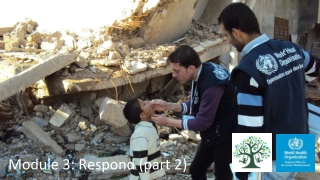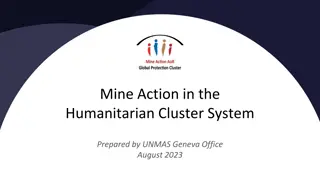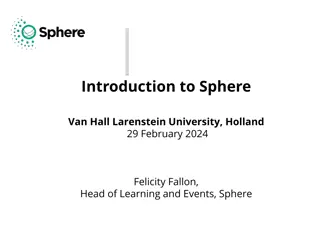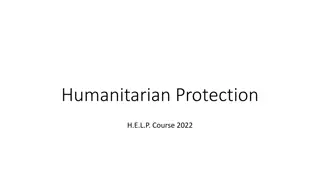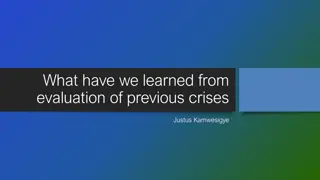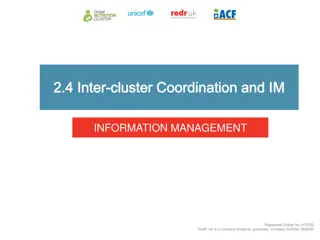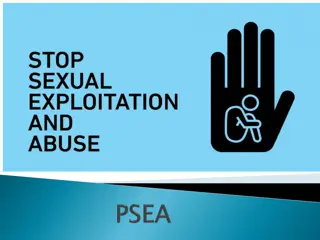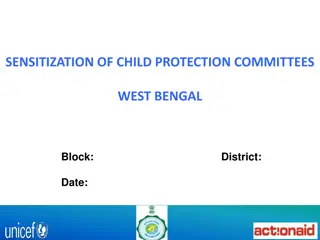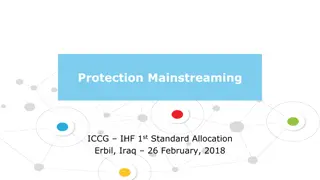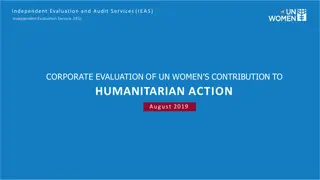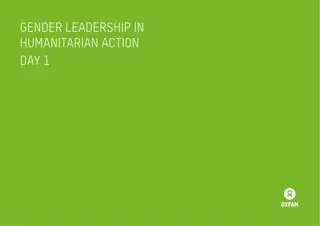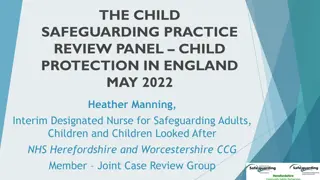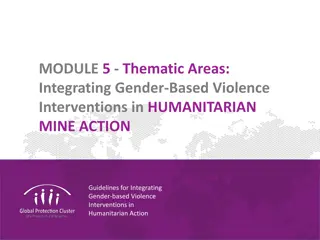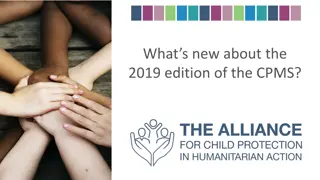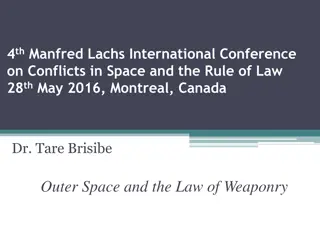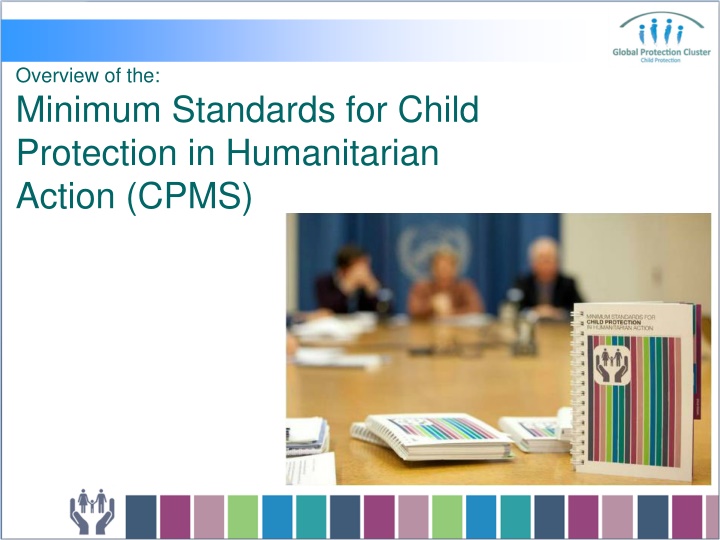
Minimum Standards for Child Protection in Humanitarian Action
The Minimum Standards for Child Protection in Humanitarian Action (CPMS) provide benchmarks and indicators to ensure quality child protection programs during emergencies. Developed by a diverse group of organizations, these standards help in evaluating and improving responses to child protection issues worldwide.
Download Presentation

Please find below an Image/Link to download the presentation.
The content on the website is provided AS IS for your information and personal use only. It may not be sold, licensed, or shared on other websites without obtaining consent from the author. If you encounter any issues during the download, it is possible that the publisher has removed the file from their server.
You are allowed to download the files provided on this website for personal or commercial use, subject to the condition that they are used lawfully. All files are the property of their respective owners.
The content on the website is provided AS IS for your information and personal use only. It may not be sold, licensed, or shared on other websites without obtaining consent from the author.
E N D
Presentation Transcript
Overview of the: Minimum Standards for Child Protection in Humanitarian Action (CPMS)
CPWG Members and Associates Bureau for Population and Refugee Migration; Government of Canada; Child Frontiers; Child Helpline International; Child Soldiers International; ChildFund International; Columbia University, CPC Network; Danish Refugee Council; Department for International Development; Displaced Children and Orphans Fund; European Commission Humanitarian Office; EveryChild; Family for Every Child; Geneva Call; GOAL; Handicap International; Heartland Alliance; International Bureau for Children's Rights; International Committee of the Red Cross; International Labour Organization; International Rescue Committee; Islamic Relief Worldwide; Keeping Children Safe Coalition; Mercy Corps; Norwegian Refugee Council; U.S. Office for Foreign Disaster Assistance; Plan International; Retrak; Refugee Point; Save the Children; SOS Children's Villages International; Swiss Agency for Development and Cooperation; Terre des Hommes; The International Institute for Child Rights and Development; United Nations Children's Fund; United Nations Department of Peacekeeping Operations; United Nations High Commission for Refugees; War Child Canada; War Child Holland; War Child UK; Watchlist on Children and Armed Conflict; and World Vision International.
The need for minimum standards for Child Protection in Emergencies "To would help organizations prepare for child protection issues during emergency response "It would provide benchmarks for what is a good enough child protection programme "To enable new cluster members at country level to benefit from evolution of the sector so far, and encourage all actors to obtain a minimum level of quality in responses" "Indicators would allow organizations to better evaluate their response work in terms of child protection"
CPMS Development Process April 2012 November 2010 July 2011 October 2012 Country Consultations (4 languages) First Meeting Large Consultation Global Launch
CPMS and other Humanitarian Standards The Sphere Project, the ICRC Professional Standards for Protection, INEE Standards, HAP and others help humanitarian actors to improve quality and accountability in Humanitarian Response. The CPMS became companion to Sphere Standards in May 2013. Sphere Companion Standards:
CPMS Objectives Establish common principles and strengthen coordination amongst child protection actors. Improve the quality of child protection programming to achieve greater impact for children. Improve accountability within the child protection sector during emergencies. Further define the professional field of child protection. Make available good practice in child protection to date. Enable better advocacy and communication on child protection risks, needs and responses.
CPMS Structure Introduction CPMS follows the Sphere Standards format Standard (one phrase) Key Actions Indicators Guidance Notes References
CPMS Foundations Survival and development Non-discrimination Child Participation Best Interest of the Child CRC Avoid exposing people to further harm Ensure people s access to impartial assistance Protect people from physical and psychological harm Assist people to claim their rights, access available remedies and recover from the effects of abuse 10 key Principles SPHERE Strengthen child protection systems Strengthen children s resilience in humanitarian action CPMS
What is a minimum standard? Agreed universal benchmarks to be achieved or aspired to without being altered. A common agreement of what needs to be achieved and adequate quality. Some Standards will need to be prioritized or phased, depending on the starting point in the context. Some Standards will not be relevant for a particular context.
Standards to ensure a quality child protection response 1. Coordination 2. Communication, advocacy and media 3. Human Resources 4. Programme cycle management 5. Information management 6. Child Protection Monitoring
Standards to address child protection needs 11. Children associated with armed forces or armed groups 7. Dangers and injuries 8. Physical Violence and other harmful practices 12. Child labor 9. Sexual Violence 13. Unaccompanied and separate children 10. Psychosocial distress and mental disorders 14. Justice for children
Standards to develop adequate child protection strategies 15.Case Management 16.Community-based child protection mechanisms 17.Child-friendly spaces 18.Protecting excluded children
Standards to mainstream Child Protection in other Humanitarian Sectors 19.Economic Recovery 20.Education 21.Health 22.Nutrition 23.WASH 24.Shelter 25.Camp Management 26.Distribution and Child Protection
Who are the standards intended for? Intended for use by those working on child protection or related areas of humanitarian action Working directly with children, families and communities; Planners and policy makers; Coordinators; Donors; Academics; Government personnel and those working in independent or multilateral organizations It may also include those working in the justice system and security personnel; As well as armed forces and groups;
How can the CPMS be used? To plan and cost humanitarian interventions To induct and train new staff or partners As self-learning tool and reference text To establish common and measurable expectations To enable advocacy on child protection issues, and to brief decision-makers on child protection To establish agreement on common principles between different actors To monitor and evaluate the allocation of funding To enable those working in other sectors of humanitarian action to protect children better 0
Implementation of the CPMS 2013-2015 Activities at National/Local Levels Raise awareness launch events, discussions Contextualize the Standards in countries Build capacity of all users (CP and other sectors) Integrate CPMS in strategies, work plans and monitoring and evaluation tools Provide feedback on the use and areas for improvement of the Standards Translate the Standards into other languages
Implementation of the CPMS 2013-2015 Global Level Support Financial and technical support for regions and countries to carry out awareness raising and capacity building activities Technical support for contextualization Development of adaptable capacity building and communication materials Monitor the use and application of the Standards Ensure Standards exist in 4 major languages
This is Samira Overview of what the CPMS are about English Espa ol Fran ais

